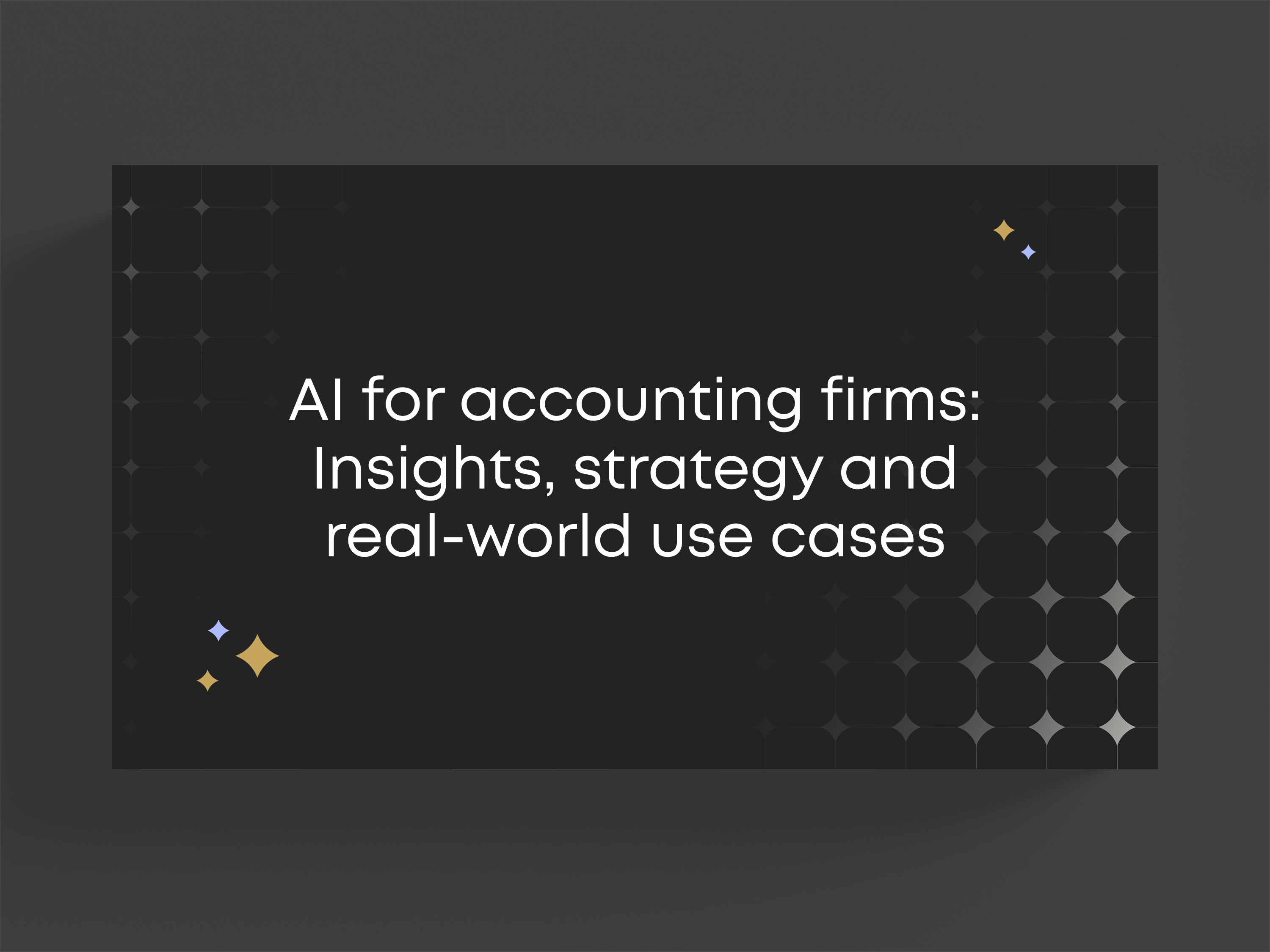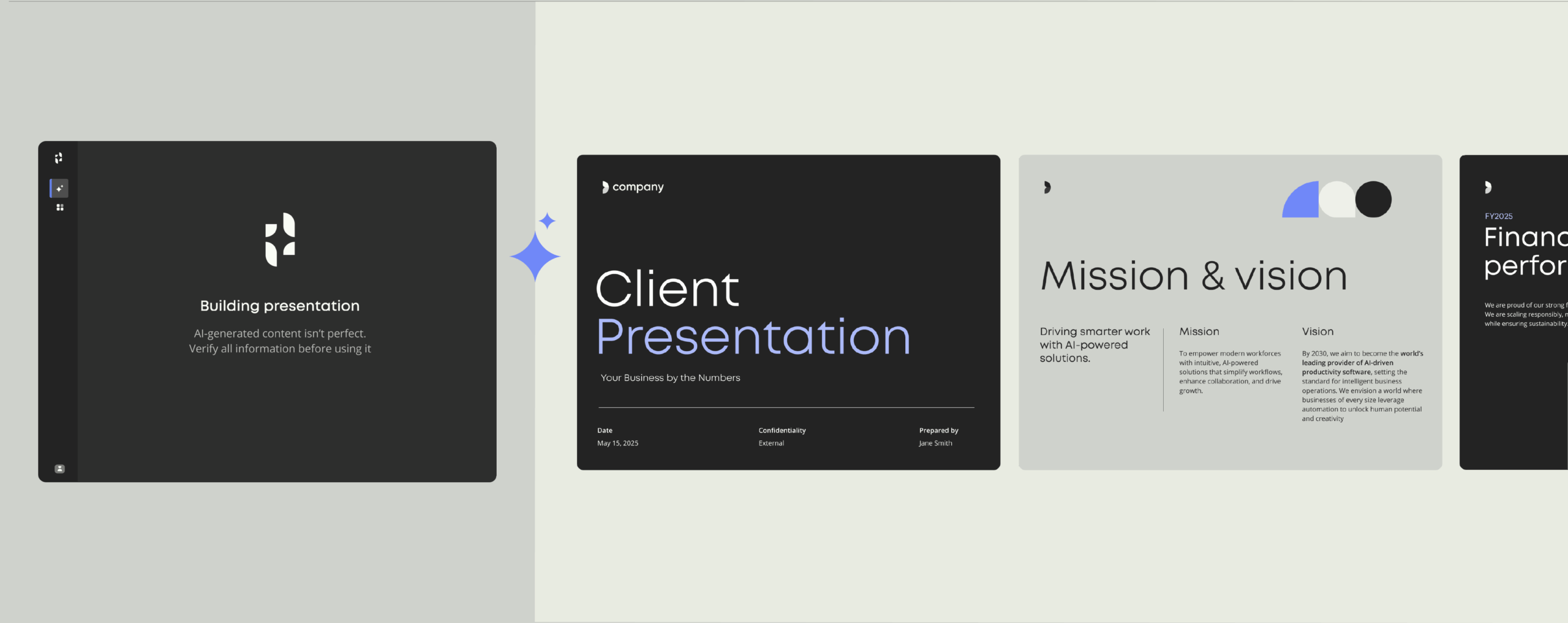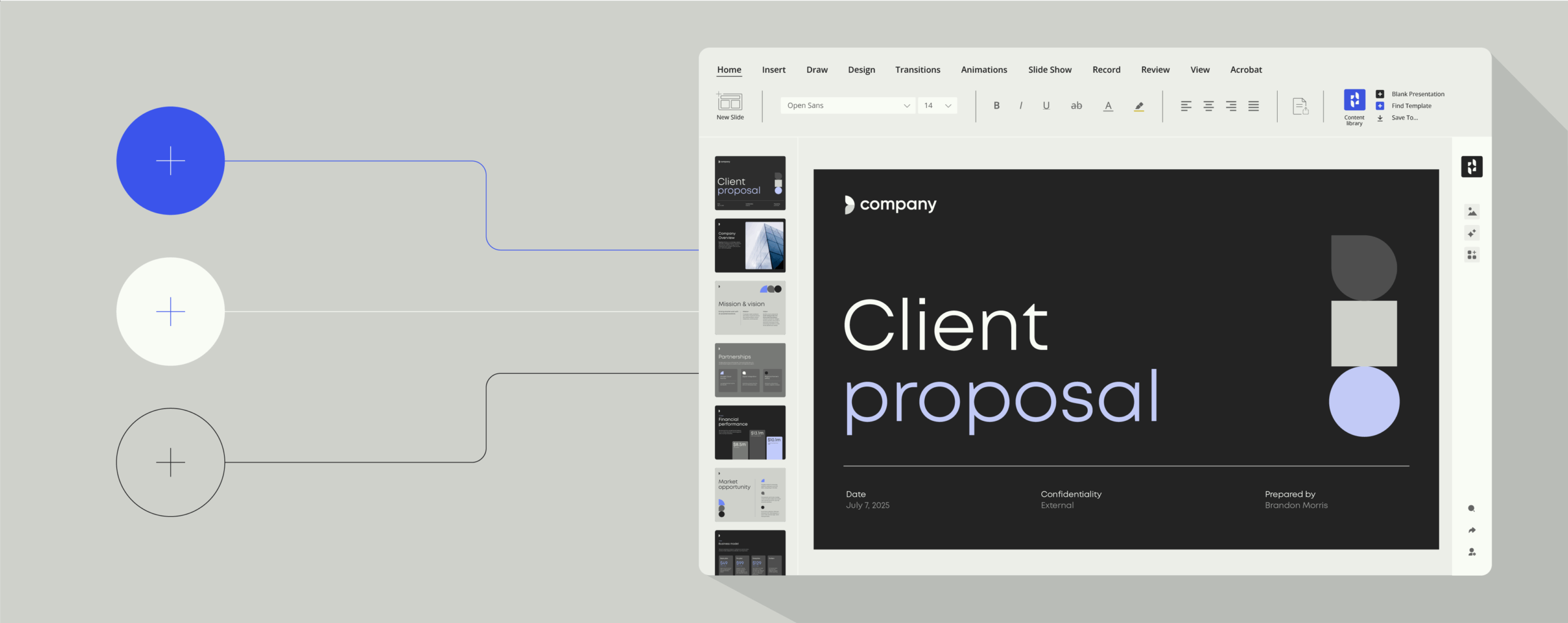How top accounting firms are saving time with document automation

Stop wasting time on document creation. Learn how to reduce errors and improve compliance.
What could you accomplish if you weren’t buried in paperwork?
Everyone’s looking for an AI tool to automate document creation. But in accounting, generic GenAI tools fall short. Financial reports and client documents carry significant risk, and even small mistakes can result in compliance issues or lost revenue.
You need a platform that ensures every document meets your firm’s standards and industry regulations. One that doesn’t just speed up workflows, but guarantees consistent, compliant, and on-brand outputs every time.
Here’s how to choose the right solution that saves you time and keeps your documents safe.
What is accounting document automation?
Accounting document automation definition
Accounting document automation uses software (often powered by AI) to create, manage, and distribute accounting documents. These tools make the process faster while also ensuring documents are accurate, compliant with regulations, and on-brand.
By automating repetitive tasks like data entry and document organization, these tools reduce mistakes, save time, and maintain consistency.
For accounting firms, this means quicker document creation, fewer errors, and more time for high-value tasks. Instead of manually preparing engagement letters or audit reports, automation tools can generate error-free, on-brand documents in minutes, allowing teams to focus on things like client consultations and financial analysis
Common accounting documents that benefit from automation
- Proposals
- Contracts
- Tax documents
- Client reports
- Invoices
- Receipts
- Purchase orders
- Financial statements
- Engagement letters
- Expense reports
Different tools automate different types of documents. Some are tailored for accounting tasks like invoices and financial statements, ensuring accuracy and compliance. Others handle a broader range of business documents, such as sales proposals and client reports, maintaining consistency across the organization.
Choose the automation platform that best aligns with your company’s needs based on where you’ll gain the greatest efficiency and ROI.
Why automating client and sales documents drives the highest ROI
Documents play a huge role in shaping client relationships, winning business, and speeding up your processes.
When every proposal, engagement letter, and client report is accurate, branded, and compliant, your team can connect with more clients, faster, and more reliably. It boosts your reputation and builds trust, all while cutting the risk of costly mistakes.
Document automation
The benefits of automating accounting documents
- Improve compliance and security
- Scale operations without sacrificing quality
- Build stronger client relationships
- Reduce costs
- Integrate seamlessly with existing systems
Work smarter with automation
Discover new ways to save time and reduce errors with document automation. See how teams use smart tools to work faster.
Here’s how automating accounting documents can make your firm more efficient, secure, and client-friendly, with real-world examples from firms who’ve already taken the leap.
1. Improve compliance and security
By centralizing control over compliance and security, your entire company stays on top of changing regulations automatically. Features like automated legal disclaimers and user-based access control ensure that every document meets compliance and security standards without extra effort, reducing risk and safeguarding sensitive data.
—ERM automated their document workflows to ensure compliance with industry regulations while maintaining brand consistency across global offices.
2. Scale operations without sacrificing quality
As your firm grows, automation helps you scale document creation without overwhelming your team. You can handle more clients while maintaining the same high quality and consistency.
—Moore standardized the quality and brand standards of their documents across a global network of 800 employees.
3. Build stronger client relationships
Faster, more accurate documents help you respond to clients quickly and consistently, making them feel valued and boosting trust in your firm.
—IComm reduced proposal creation time from 4 hours to 20 minutes by automating the process, allowing them to engage clients faster and increase win rates.
4. Reduce costs
By eliminating repetitive manual tasks and minimizing errors, automation lowers operational costs and frees up your team to focus on higher-value work.
—ERM saved 63,000+ hours in the first year by automating their document creation process, cutting down on manual checks and improving overall efficiency.
5. Integrate seamlessly with existing systems
The best automation tools integrate easily with your CRM, accounting software, and cloud platforms, ensuring smoother workflows and better data consistency across systems.
—Bonava integrated their DAM with document automation, streamlining workflows and ensuring data stayed accurate across all systems.
Key features to look for in accounting document automation
When you’re choosing a document automation platform, it’s easy to get overwhelmed by the options. But what really matters is how well the platform simplifies your life.
The right system should cut down on manual work, boost accuracy, and ensure your documents stay secure and compliant. Here’s what to focus on when picking the perfect solution for your firm.
Integration with financial systems and tools
You don’t want to be juggling multiple systems. Look for a platform that integrates seamlessly with your financial software and tools like Microsoft 365 or Google Workspace. This ensures your data flows effortlessly from one system to the next, cutting out manual data entry and minimizing errors.
For instance, when you generate a financial statement, the platform will automatically pull data from your accounting software, ensuring everything is up-to-date and accurate.
Secure access and version control
Security is non-negotiable when dealing with financial documents. You need a system that lets you control who can access and edit sensitive information. With role-based access and version control, your documents are protected and every change is logged.
You can also secure client invoices and reports so only the right people can access or edit them, while keeping track of who made changes and when.
Template-based document creation
Consistency is key, especially when dealing with client-facing documents. By using standardized templates, you can ensure that every invoice, proposal, or report is always accurate, on-brand, and compliant. Templates are automatically updated, so you don’t have to worry about manually checking each document for updates.
Whether it’s a financial report or an engagement letter, your team will always be using the most up-to-date templates, keeping your documents consistent and error-free.
Real-time updates and reporting
When things change, you need a system that can keep up. The right platform will let you instantly roll out updates across all your documents.
Whether it’s a change in compliance regulations or a tweak to your branding, every document will be updated in real-time, saving you from having to make manual adjustments for every department.
So, if your firm adopts a new tax policy, you can be sure that every document template reflects the latest rules without delay.
Use cases: How teams use automation in accounting
Here’s what that looks like in practice.
1. Engagement letters and client proposals
Client documents like engagement letters and proposals are crucial to your business, but creating them manually is a huge time-drain on your highly skilled professionals.
Automation makes it easy to generate these documents quickly by pulling client data and contract terms into pre-designed templates, ensuring that everything is accurate, compliant, and aligned with your firm’s branding.
Every time you onboard a new client or prepare a proposal, automation handles the heavy lifting, allowing your team to focus on building stronger client relationships.
2. Internal audits and compliance documentation
Internal audits and compliance reviews are essential but can be stressful. Automation helps you keep everything organized and compliant by centralizing your records and ensuring version control. It tracks every document update, making audits easier and reducing the risk of missing documents or errors.
During an audit, you can quickly pull up all required documents, with every change logged and fully compliant with internal policies.
3. Managing financial reports
Generating audit reports can be a slow, tedious process. But with automation, you can generate up-to-date reports in minutes. Built-in compliance features ensure that your reports are always accurate and reflect the latest data, so you can avoid surprises at quarter-end.
Instead of spending hours compiling data, your team can focus on making strategic decisions while the automation system generates and distributes reports with just a few clicks.
4. Automating invoice generation and approval
Manually creating and approving invoices is time-consuming and prone to errors. Automation removes the guesswork by pulling data from your systems to generate accurate invoices automatically. Plus, it sends invoices through an approval chain to ensure they’re reviewed quickly and accurately.
Rather than spending time re-entering data, automation generates the invoice, sends it for approval, and gets it out the door faster, improving your cash flow.
5. Expense report workflows
Expense reports are another area that can be a real time-drain. With automation, you can capture expense data automatically, check it against company policies, and route it for approval, all without manual input. This reduces the time spent on tracking expenses and cuts down on mistakes.
Employees submit their expenses, and the system handles the rest: validating, categorizing, and sending it for approval so everyone gets reimbursed faster.
guide
AI for accounting firms: Insights, strategies, and real-world use cases
Want to know how top accounting firms are using AI? Discover the top five accounting challenges today and how AI is solving them.

Case studies
When you choose the right document automation platform, the results speak for themselves, delivering measurable ROI across your entire firm.
Here are two success stories from accounting firms that have turned document creation into a streamlined, cost-saving process with Templafy.
How document automation saved BDO Canada $1.65 million in one year
BDO Canada, one of the country’s largest professional services firms, needed a way to ensure consistency across their 80+ offices, especially when it came to branding, templates, and compliance. With Templafy, they centralized everything and integrated it directly into their Microsoft Office tools.
The results:
- $1.65 million saved in just one year by cutting down manual document creation time
- Simplified engagement letter templates from 24 to just 4, streamlining maintenance
- Built a centralized library of 600+ templates that automatically update for accuracy and compliance
“Templafy has made it easy for us to maintain consistency across the firm and save significant resources. The integration with Microsoft Office is a game changer.”
— Brion Hendry, Partner and Assurance Innovation Leader, BDO Canada
How Moore Belgium streamlined M&As with document automation
Moore Belgium, the largest independent accountancy and consulting firm in Belgium, faced challenges aligning critical documents—like logos, templates, and standardized text—across numerous mergers and acquisitions. Templafy solved the problem by simplifying and standardizing document creation across the entire firm.
Here’s what happened:
- Rapid adoption across the company, with Templafy becoming the second-most used tool after Microsoft Office
- Significant improvements in document quality and precision
- Boosted employee confidence in AI, driving widespread adoption
“There is tough competition in our space. We need to move fast and be ahead of the curve to win business. Templafy is a tool for that.”
— Sebastien Dubrulle, CIO, Moore Belgium
How Templafy supports accounting teams
Documents are more important in the age of virtual and hybrid selling, and cross functional alignment is important for sales enablement in any streamlined organization.
Accuracy, compliance, and efficiency are critical in accounting. Templafy gives your team the tools to produce high-quality, compliant documents without manual effort. Here’s how:
1. Speed up document creation with AI and automation
Eliminate repetitive tasks like manual data entry and formatting. Templafy connects to your accounting systems, Microsoft 365, and Google Workspace to automatically populate documents with real-time, accurate data—so your team can focus on client work instead of paperwork.
Read about Templafy’s document automation.
2. Keep every template current and compliant
No more chasing the latest version. Templafy instantly updates all templates with the newest regulations, branding guidelines, and legal disclaimers, so every document is audit-ready the moment it’s created.
Read about Templafy’s dynamic templates.
3. Work from the tools you already use
Your team doesn’t need another platform to log into. Templafy delivers automation and AI directly inside your day-to-day applications, allowing you to generate proposals, reports, and contracts without disrupting workflows.
Browse Templafy’s integration library.
4. Protect sensitive financial data
Role-based access controls, encryption, and audit logs ensure only the right people can access or edit financial documents. Every change is tracked, making it simple to stay compliant and secure during audits.
Read about Templafy’s enterprise-grade security.
5. Boost productivity without adding headcount
Your skilled employees are too valuable to waste time on document admin. With Templafy, they spend less time formatting and more time delivering high-value accounting services to clients.
Get a full platform overview.
Choosing the right automation strategy
The key to successfully implementing document automation lies in how you scale it. With Templafy, you can start small with high-impact document types and expand your automation as you see results. Here’s how you can make the most of Templafy’s automation capabilities:
Start small, scale intentionally
There’s no need to automate everything at once. Start with the most repetitive or error-prone documents, like invoices or financial reports. Once you see the impact, expand your automation strategy to cover more workflows and document types, ensuring maximum return on investment.
Focus on security and compliance readiness
Templafy has built-in security features, like role-based access and full encryption, to protect sensitive financial data. When selecting an automation platform, ensure it has these essential compliance features. Templafy not only keeps your data secure but also ensures that all documents adhere to the latest regulations, so your firm is always prepared for audits.
Evaluate ROI through time saved and error reduction
With Templafy, you can easily measure the impact of automation by tracking the time saved, reduction in errors, and improvements in audit scores. When you reduce manual work, you free up valuable hours for your team, allowing them to focus on high-value tasks like client relationships and business strategy.
Why Templafy?
Here’s why Templafy stands out:
- Save time on proposals: Cut proposal generation time by 92%, from 4 hours down to just 20 minutes. Learn more
- Trusted by top brands: Over 4 million users globally, including big names like BDO, EY, KPMG, and Adobe. See who trusts us
- Compliant and secure: Built-in controls, enterprise integrations, and compliance features at the core.
- Real ROI: BDO Canada saved $1.65 million in one year, gained back 3–4 hours per employee weekly, and reduced document errors by 30%. Read the full story
“Today, every engagement letter across BDO Canada is created using Templafy. What started as a pilot quickly became essential to our workflow.” — Brion Hendry, Partner and Assurance Innovation Leader, BDO Canada
Ready to automate your accounting documents?
Don’t waste another minute on manual document work. Book a personalized walkthrough of our document automation platform to see how easy it is to save time, reduce errors, and improve efficiency across your enterprise.
Get a personalized demo
Explore how Templafy supports accounting teams



